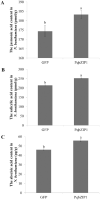A bZIP transcription factor, PqbZIP1, is involved in the plant defense response of American ginseng
- PMID: 35282281
- PMCID: PMC8916028
- DOI: 10.7717/peerj.12939
A bZIP transcription factor, PqbZIP1, is involved in the plant defense response of American ginseng
Abstract
American ginseng (Panax quinquefolius L.) is a perennial medicinal plant that has a long usage history in China. However, root rot, which is mainly caused by Fusarium solani can severely reduce the yield and quality of American ginseng, but no disease-resistant variety of American ginseng exists, and the resistance against this disease is not yet well understood. Thus, it is very urgent to analyze the interaction mechanism regulating the interactions between American ginseng and F. solani to mine disease resistance genes. Using transcriptome data and quantitative polymerase chain reaction (qPCR), we screened the transcription factor PqbZIP1 in response to induction by chitin. Yeast self-activation and subcellular localization experiments proved that PqbZIP1 showed transcriptional activity and was localized in the plant nucleus. In addition, qPCR showed that the highest relative expression level was in the roots, wherein chitin and F. solani inhibited and activated the expression of PqbZIP1, respectively, in American ginseng. Additionally, PqbZIP1 significantly inhibited the growth of the Pseudomonas syringae pv. tomato D36E strain in Nicotiana benthamiana, where expressing PqbZIP1 in N. benthamiana increased the jasmonic acid, salicylic acid, and abscisic acid content. Furthermore, PqbZIP1 expression was continually increased upon inoculation with F. solani. Hence, this study revealed that the PqbZIP1 transcription factor might mediate multiple hormonal signaling pathway to modulate root rot disease resistance in American ginseng, and provided important information to breed disease-resistant American ginseng.
Keywords: American ginseng; Disease resistance genes; Fusarium solani; Immune response; Panax quinquefolius L.; PqbZIP1; Root rot disease.
© 2022 Yang et al.
Conflict of interest statement
The authors declare that they have no competing interests.
Figures











References
-
- Chao S, Li Y, Wu Q, Luo H, Sun Y, Song J, Lui EM, Chen S. De novo sequencing and analysis of the American ginseng root transcriptome using a GS FLX Titanium platform to discover putative genes involved in ginsenoside biosynthesis. BMC Genomics. 2010;11:262. doi: 10.1186/1471-2164-11-262. - DOI - PMC - PubMed
Publication types
MeSH terms
Substances
LinkOut - more resources
Full Text Sources

